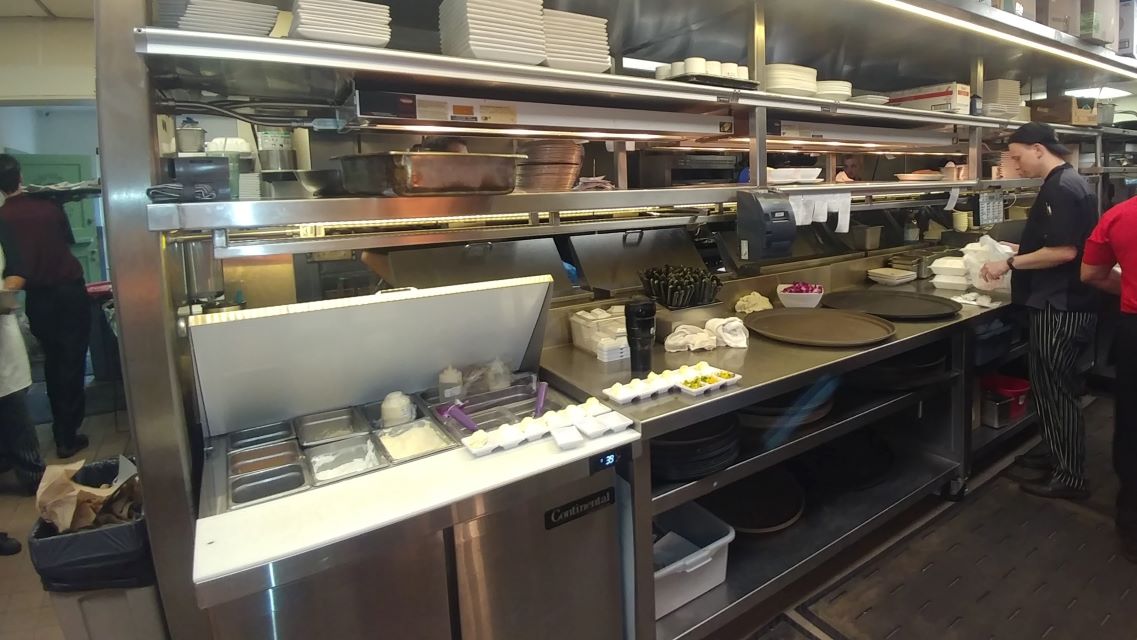As you plan your commercial kitchen, you must ponder functionality, efficiency, and safety. Work tables are the backbone of your food preparation area, providing the necessary space for chopping, mixing, and assembling dishes. You’ll find various options, from sturdy stainless steel to warm wooden surfaces, each offering unique benefits for your culinary workflow. But choosing the right table isn’t just about material—it’s about optimizing your space, enhancing productivity, and maintaining hygiene standards. The design of your work tables can make or break your kitchen’s performance. So, what features should you prioritize to create the ideal workspace for your culinary team?

Types of Commercial Kitchen Tables
Variety is the hallmark of commercial kitchen work tables. When planning your food preparation layout, you’ll encounter several types designed to meet diverse work surface requirements. Stainless steel tables are popular for their durability and ease of cleaning, making them ideal for high-volume kitchens. Wood tables offer a classic aesthetic and are often preferred for pastry work. Poly tables provide a lightweight, non-porous option suitable for various tasks.
Prep tables are key for streamlining workflow efficiency analysis. They’re equipped with built-in sinks, cutting boards, and storage compartments, optimizing the food preparation process. Sturdy equipment stands are integral for equipment placement strategies. These tables support heavy appliances, ensuring stable operation and proper temperature control.
Work tables with shelving units combine workspace and storage, maximizing kitchen area utilization. They’re particularly useful in compact kitchens where space is at a premium. Mobile work tables on casters offer flexibility, allowing you to adapt your kitchen layout as needed. These tables can be easily moved to create temporary workstations or to accommodate changing workflow patterns, enhancing overall kitchen efficiency.
Material Selection and Durability
Durability and functionality are paramount when selecting materials for commercial kitchen work tables. Stainless steel tables dominate the market due to their superior corrosion resistance, impact on food preparation, and ease of cleaning and disinfection. The 14-gauge stainless steel option offers the highest durability, ideal for heavy-duty tasks in butcher shops and high-volume kitchens.
While wooden tables provide a traditional aesthetic, they may not withstand the rigors of commercial kitchens, particularly in high-humidity environments. Their performance can be compromised, affecting food safety and preparation efficiency. Poly (plastic) tables offer a cost-effective alternative for less demanding kitchen environments. They’re lightweight but may have limited weight-bearing capacity compared to stainless steel options.
Your choice of material should align with your kitchen’s specific needs, balancing durability, functionality, and cost. Consider the table’s intended use, cleaning frequency, and moisture exposure. Stainless steel remains the gold standard for its overall performance in commercial kitchens, ensuring longevity and maintaining hygiene standards essential for food preparation areas.

Ergonomic Design Considerations
Three primary ergonomic design considerations enhance the functionality of commercial kitchen work tables. First, adjustable height mechanisms and custom base configurations allow you to tailor the table’s height to suit individual users. This adaptability reduces strain on the back and shoulders during food preparation, accommodating chefs of varying statures.
Second, task-specific surface heights optimize workflow efficiency. Different culinary tasks may require distinct working heights, and ergonomically designed tables can address these needs through modular or multi-level surfaces.
Third, ergonomic edge profiles, such as rounded corners, minimize the risk of injury and facilitate comfortable hand movements. These design features contribute to improved musculoskeletal health benefits for kitchen staff.
To further enhance ergonomics, consider incorporating anti-fatigue mats at workstations. These mats alleviate foot and leg discomfort during long shifts, promoting overall comfort and productivity.
Storage and Organization Features
Exceeding ergonomic design, commercial kitchen work tables offer an array of storage and organization features that streamline operations and enhance efficiency. Integrated drawers and shelves provide convenient storage for kitchen tools, utensils, and supplies, allowing for a designated compartment layout that optimizes workspace utilization.
Enclosed base work tables with cabinets offer concealed storage solutions for ingredients, equipment, and other requisites, maintaining a clutter-free environment.
Mobile work tables with casters enable modular table configurations, allowing chefs to rearrange the workspace. This flexibility extends to collapsible workspace elements, which can be adjusted to accommodate varying kitchen requirements.
Overshelves mounted on work tables add space for frequently used items, creating an efficient vertical storage system.
Adjustable shelving systems within the work tables allow for customization based on the size and type of items being stored. Filler tables can be positioned alongside work tables to expand available workspace and storage capacity, further enhancing the kitchen’s organizational capabilities. These storage and organization features collectively contribute to a well-organized, efficient commercial kitchen environment that supports culinary excellence.
Customization Options for Workspaces
Commercial kitchen work tables offer many customization options to tailor workspaces to specific culinary needs. Modular configurations can be adapted to your kitchen’s layout, allowing for efficient use of available space. Customizable accessories like shelves, drawers, and casters enhance functionality and provide versatile storage solutions.
Adaptable surface layouts enable you to optimize your work area for various food preparation tasks. Based on your kitchen’s requirements, you can choose from different tabletop materials, such as stainless steel, poly, or wood. Personalized height adjustments guarantee ergonomic comfort for chefs of varying statures, reducing strain during long working hours.
Versatile edge profiles, including square, rounded, and countertop styles, impact aesthetics, and practicality. Select the edge type that best suits your kitchen’s design and food preparation needs. Backsplash options ranging from 1.5 to 10 inches provide varying degrees of wall protection and splash resistance, allowing you to tailor your workspace to specific hygiene requirements. By carefully considering these customization options, you can create a highly efficient and personalized work environment that enhances culinary creativity and productivity.

Hygiene and Sanitation Aspects
Maintaining impeccable hygiene and sanitation standards is paramount in commercial kitchens, and work tables play a vital role. Stainless steel work tables are the preferred choice due to their ease of cleaning and sanitizing. These tables often feature rounded or bullnose edges to prevent food and dirt buildup, ensuring efficient disinfection methods. When selecting work tables, consider options with antimicrobial surface treatments for added protection against harmful microorganisms.
To maximize hygiene in your kitchen, implement these practices:
- Regularly clean and disinfect work table surfaces
- Use built-in sinks or drainboards for efficient handwashing
- Store tools and ingredients properly under work tables
- Implement temperature monitoring protocols for food safety
- Conduct routine food contact surface testing
Efficient waste management systems are indispensable for maintaining a clean workspace. Incorporate designated areas for waste disposal near your work tables to minimize cross-contamination risks. By adhering to these hygiene and sanitation practices, you’ll create a safer environment for food preparation and comply with health regulations in commercial food service settings. Remember, proper sanitation of your work tables is pivotal for ensuring the quality and safety of the food you prepare.
Space Optimization Techniques
Space optimization is important for maximizing efficiency and productivity in contemporary, fast-paced commercial kitchens. To achieve this, you must implement strategic zoning techniques and conduct a thorough workflow analysis.
Start by strategically placing work tables to create an efficient flow and maximize available kitchen space. This approach can greatly enhance your productivity.
Consider incorporating height-adjustable tables to enable customized ergonomics for various tasks and user preferences. Modular and mobile work tables offer layout flexibility, allowing you to rearrange the kitchen as needs evolve. Carefully position tables near prep sinks, cooking equipment, and storage areas to minimize travel distances during food preparation.
Use custom configurations to employ corner spaces and dead zones to optimize space utilization. These custom-sized tables can help you make the most of every square inch in your commercial kitchen. By implementing these space optimization techniques, you’ll create a more efficient work environment that supports your culinary operations. Remember, a well-designed kitchen layout with strategically placed work tables can dramatically improve your team’s performance and overall kitchen functionality.
Maintenance and Longevity Tips
While optimizing your kitchen layout is pivotal, ensuring the longevity of your work tables is equally important for sustained efficiency. Implement a regular cleaning schedule and follow proper cleaning procedures to maintain hygiene and prevent surface damage.
Establish a preventative maintenance plan to address minor issues before they escalate into major problems.
To maximize the lifespan of your commercial kitchen work tables:
- Conduct routine inspections to identify signs of wear or damage
- Clean surfaces immediately after use to prevent staining or corrosion
- Apply food-safe lubricants to moving parts, such as drawer slides
- Tighten loose bolts and screws regularly to maintain stability
- Train staff on proper storage and handling techniques
Proper storage and handling are indispensable for preserving the integrity of your work tables. Avoid overloading surfaces with heavy equipment or stacking items excessively. When moving tables, lift rather than drag to prevent damage to legs and casters.
Implement a system for reporting and addressing maintenance issues promptly. By following these maintenance and longevity tips, you’ll extend the life of your commercial kitchen work tables, ensuring consistent performance and minimizing replacement costs.
The Impact of Quality Work Tables
Commercial kitchen work tables are indispensable assets in any food preparation environment. You can optimize workflow and hygiene by selecting the right materials, ergonomic design, and customization options. To maximize efficiency, integrate storage solutions and space-saving techniques. Regular maintenance guarantees longevity. The theory that well-designed work tables improve kitchen productivity is substantiated by their impact on organization, safety, and staff performance.
All Southern Fabricators understand the critical role of high-quality work tables in commercial kitchens. Our expertise in crafting durable, customized solutions ensures your kitchen operates efficiently. Investing in top-tier work tables means you’re not just purchasing furniture but enhancing your culinary operation.
Ready to transform your commercial kitchen? Take the first step towards optimizing your workspace. Contact All Southern Fabricators today to explore our range of commercial kitchen work tables and discover how we can elevate your kitchen’s performance to new heights.

